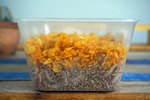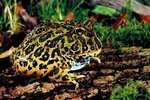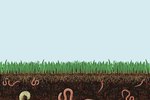
African dwarf frogs are not picky eaters. If they can get it in their mouth, they will attempt to eat it. The trick to feeding these frogs in captivity is providing a variety of protein-rich sources similar to what they eat when wild. They aren't adept scavengers, thus it is important to place food right in front of them. Use a small shallow dish or a syringe or turkey baster to deliver food.
Brine Shrimp
African dwarf frogs heartily eat brine shrimp, fresh or frozen. In nature, brine shrimp live in saltwater isolated from the ocean, such as the Great Salt Lake in Utah. Most pet stores sell either fresh or frozen brine shrimp. These 1/2-inch crustaceans make tasty meals or treats for frogs. Use the syringe or turkey baster method to capture live brine shrimp and deliver them to the frogs. The same method works for frozen brine shrimp, just without the capturing. Avoid offering too much frozen brine shrimp, as any leftovers will dirty your frog's home. Offer live brine shrimp to frogs who don't live in fully aquatic environments in a shallow water dish. Those that the frogs don't eat immediately can swim around until they become the next meal -- you don't have to remove these.
Worms
Various types of worms are a mainstay in the diet of African dwarf frogs. These frogs readily accept earthworms, bloodworms and nightcrawlers as chow. Frogs enjoy fresh worms, but storing them and feeding them can get cumbersome and messy. Frozen worms are available at pet stores, fishing supplies and the sporting good section of big box retailers. Chop earthworms or night crawlers into bite-size pieces and place them in front of frogs to feed. Don't feed live bloodworms: These wiggly critters have tiny hooks on their mouths that they use to hang on to predators in attempts to avoid being eaten. Once frozen, bloodworms lose the effectiveness of their hooks.
Tadpole Bites
Some African dwarf frogs will eat commercial tadpole bites and others simply refuse them. Tadpole bites are nutrient-dense pellets that easily sink to the bottom of aquariums where fully aquatic frogs tend to hang out. Most tadpole bites contain fish meal, fish oil, dried brewer's yeast, beet powder, rosemary extract, various extracts of vitamins A, B, C and E as well as wheat flour, gluten, starch and other trace minerals.
Gammarus
Gammarus are amphipods, which are crustaceans that have 13 body segments. Most live in marine waters but several species prefer freshwater lakes, rivers, streams, ponds, brooks and springs. They are most active at night, which coincides with the nocturnal eating habits of African dwarf frogs. They crawl and walk by using their legs and by flexing their bodies. When swimming, they roll to their sides. They tend to live at the bottom of whatever water source they are in: It is advisable to put them in a shallow dish of water for frogs not living in fully aquatic environments. Gammarus are available at pet stores as adults and as larvae that you can hatch. The truly adventurous can collect gammarus from wild environments, but doing so might be neither cost-effective or a productive use of time.
Frozen Beefheart
It is exactly what is sounds like: Frozen beefheart is heart from cattle that has been frozen. It is high in protein. Frozen beefheart is a treat for frogs; African dwarf frogs eat it with the same enthusiasm as toddlers do candy. Feed it only once a week to avoid its fatty content from causing premature organ failure.
Wild Dining
As with other critters kept in captivity, the diet of pet African dwarf frogs varies from that of their wild counterparts. This frog is mainly found in the Congo River regions of Africa. In the wild, they have a carnivorous diet consisting of live shrimp, other small crustaceans, bug larvae and worms. While many other amphibians will snatch insects midair as snacks, the African dwarf frog is not interested in bugs for food.
References
Photo Credits
-
Ryan McVay/Photodisc/Getty Images
Writer Bio
Amy M. Armstrong is a former community news journalist with more than 15 years of experience writing features and covering school districts. She has received more than 40 awards for excellence in journalism and photography. She holds a Bachelor of Arts in communications from Washington State University. Armstrong grew up on a dairy farm in western Washington and wrote agricultural news while in college.




